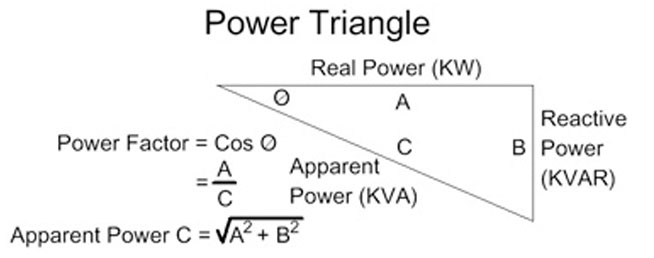Power Factor Correction
Power factor is the ratio of active (real) power kW divided by the total (apparent) power kVA. See the power triangle below for this discussion.
Special electrical requirement of inductive loads:
Poor power factor is primarily caused by inductive loads. Most loads in modern electrical distribution systems are inductive. Examples include motors, transformers, fluorescent & HID lighting ballasts, and induction furnaces. Inductive loads need a magnetic field to operate.
Inductive loads require two kinds of current:
- Working power (kW) to perform the actual work of creating heat, light, motion, machine output, etc. Working power consumes watts and can be read on a wattmeter. It is measured in kilowatts (kW)
- Reactive power (kVAR) to sustain the magnetic field. Reactive power doesn’t perform useful “work,” but circulates between the generator and the load. It places a heavier drain on the power source, as well as on the power source’s distribution system. Reactive power is measured in kilovolt-amperes-reactive (kVAR).
Working power and reactive power together make up apparent power. Apparent power is measured in kilovolt-amperes (kVA).

You can improve power factor by adding power factor correction capacitors to your distribution system. When apparent power (kVA) is greater than working power (kW), the utility must supply the excess reactive current plus the working current. Utility companies can charge you for low power factor. Low power factor means you’re not fully utilizing the electrical power you’re paying for.
Benefits of increasing power factor
- Reduce electrical bills – usually a relatively short payback period
- Increase (release) system capacity
- Reduce power losses
- Voltage improvement
